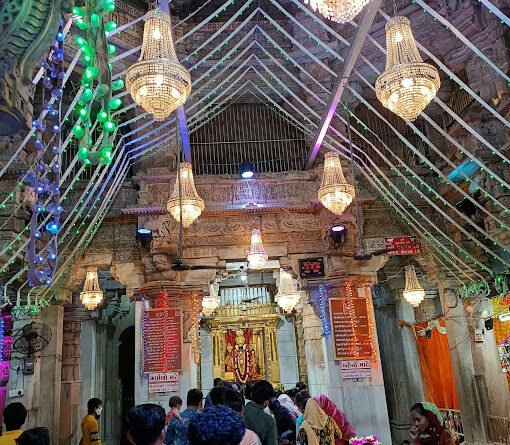Shree Shamlaji Vishnu Mandir
Shamlaji, also spelled Shamalaji, is a major Hindu pilgrimage centre in Aravalli district of Gujarat state of India. The Shamlaji temple is dedicated to Vishnu. Several other Hindu temples are located nearby.
The present temple dedicated to Shamlaji, a form of Vishnu was perhaps started in the 11th century in Chaulukya style, but the present structure dates from the 15th-16th centuries. The sculpture of Vishnu in the sanctuary is probably seventh-8th century, and the small temple opposite houses a sixth-century sculpture of Shiva.The oldest intact temple is the small ninth-century Harishchandrani Chauri Temple, with a gateway nearby. Several ruins of temples, scattered idols and old brick-works surrounding the place establishes antiquity of the place.
A fourth-century Buddhist monastery and stupa at Devnimori is about two kilometres (1.2 mi) away, but is now under by the waters of the Meshvo Reservoir.This site dates to the Mauryan period, and a much older microlith site known as Dhek-Vadlo locally was found near Shamlaji.
Shamlaji was an important Hindu centre in the sixth century, probably the home of a sculpture workshop whose creations are found as far away as Mumbai, where the Parel Relief was found. Most of the ancient sculpture found at Shamlaji, in blueish schist, has now been removed to museums, especially to Mumbai and Vadodara.
Shamlaji temple
Shamlaji temple is located on the banks of the Meshvo river in the valley surrounded by well wooded hills.
It is also referred to as Dholi Dhajawala due to white silk flag fluttering on top of the temple.
Built of white sandstone and brick it is surrounded by a wall with a gateway. It is of two stories, supported on pillars, and a canopy with arches on each side. The lower courses of richly carved stone are of great age. Above them runs a frieze with an unintelligible pattern, and, above this, running right round the building, a fringe of elephants’ heads and forequarters carved in stone. Above this is a very ranch worn frieze full of figures in bass-relief, men on horseback with bows, and animals. The elephant is a very frequent emblem. Besides the fringe frieze above mentioned, there are, on the outer wall, between every two angles, larger figures of semi-rampant elephants standing out in relief, and, in front of the entrance, stands on either side of the doorway a gigantic cement elephant. Above the shrine, a pyramid-based tower rises into a spire like a high-shouldered cone with flattened sides. The forepart of the roof consists of a number of small domes springing from a flat roof, or rather of a flat trabeate roof, with domes here and there, the largest being in the centre. Outside at all the angles of the roof are figures of animals and the gargoyles.On walls, there are some scenes from the epics Mahabharata and Ramayana.
Of the two inscriptions, one is to the left in the upper story and bears date 94 AD and 102 AD. This writing, cut in stone, is not very archaic and could not be of the date it professes to record. It may be a transcript of an older inscription or the record of an old tradition. The other, on copper at the entrance of the temple, records repairs executed in 1762 AD by the then Thakor of Tintoi. From these two inscriptions, name of the deity seems to be Gadadharji, the holder of the club, a well known title of Vishnu, Krishna, or Shamlaji.The cow idols are also worshiped depictiong childhood of Krishna as cowherd. It is one of the 154 important pilgrimage sites of Vaishnavism.The temple was claimed by Jains in the past.
Years ago the Idar State rulers gave the fiefdom of Shamlaji temple to the Modhari Rao Saheb with other villages like Revdar, Devdar, Napada, Khalsa, Sunsar, Modhari, etc. The Rao of Modhari still holds trusteeship of Shamlaji Temple.



















